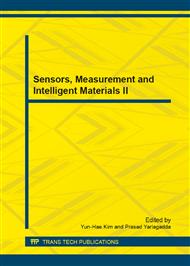[1]
Jänis P, Yu C H, Doppler K, et al. Device-to-Device Communication Underlaying Cellular Communications Systems[J]. IJCNS, 2009, 2(3): 169-178.
DOI: 10.4236/ijcns.2009.23019
Google Scholar
[2]
Hakola S, Chen T, Lehtomaki J, et al. Device-to-device (D2D) communication in cellular network-performance analysis of optimum and practical communication mode selection[C]/Wireless Communications and Networking Conference (WCNC), 2010 IEEE. IEEE, 2010: 1-6.
DOI: 10.1109/wcnc.2010.5506133
Google Scholar
[3]
Chen X, Chen L, Zeng M, et al. Downlink resource allocation for Device-to-Device communication underlaying cellular networks[C]/Personal Indoor and Mobile Radio Communications (PIMRC), 2012 IEEE 23rd International Symposium on. IEEE, 2012: 232-237.
DOI: 10.1109/pimrc.2012.6362746
Google Scholar
[4]
Zulhasnine M, Huang C, Srinivasan A. Efficient resource allocation for device-to-device communication underlaying LTE network[C]/Wireless and Mobile Computing, Networking and Communications (WiMob), 2010 IEEE 6th International Conference on. IEEE, 2010: 368-375.
DOI: 10.1109/wimob.2010.5645039
Google Scholar
[5]
Wang B, Chen L, Chen X, et al. Resource allocation optimization for device-to-device communication underlaying cellular networks[C]/Vehicular Technology Conference (VTC Spring), 2011 IEEE 73rd. IEEE, 2011: 1-6.
DOI: 10.1109/vetecs.2011.5956157
Google Scholar
[6]
Liu Q, Yu H, Chen C W. Enhancing multimedia QoS with device-to-device communication as an underlay in lte networks[C]/Multimedia and Expo (ICME), 2013 IEEE International Conference on. IEEE, 2013: 1-6.
DOI: 10.1109/icme.2013.6607563
Google Scholar
[7]
Zhu X, Wen S, Cao G, et al. QoS-based resource allocation scheme for Device-to-Device (D2D) radio underlaying cellular networks[C]/Telecommunications (ICT), 2012 19th International Conference on. IEEE, 2012: 1-6.
DOI: 10.1109/ictel.2012.6221213
Google Scholar
[8]
Su L, Ji Y, Wang P, et al. Resource allocation using particle swarm optimization for D2D communication underlay of cellular networks[C]/Wireless Communications and Networking Conference (WCNC), 2013 IEEE. IEEE, 2013: 129-133.
DOI: 10.1109/wcnc.2013.6554551
Google Scholar
[9]
Lee D H, Choi K W, Jeon W S, et al. Resource allocation scheme for device-to-device communication for maximizing spatial reuse[C]/Wireless Communications and Networking Conference (WCNC), 2013 IEEE. IEEE, 2013: 112-117.
DOI: 10.1109/wcnc.2013.6554548
Google Scholar
[10]
Nguyen H A, Van Nguyen T, Choi D. How to maximize user satisfaction degree in multi-service IP networks[C]/Intelligent Information and Database Systems, 2009. ACIIDS 2009. First Asian Conference on. IEEE, 2009: 471-476.
DOI: 10.1109/aciids.2009.16
Google Scholar
[11]
Hu J, Zeng X, Xiao J. Artificial Fish School Algorithm for Function Optimization[C]/ Information Engineering and Computer Science (ICIECS), 2010 2nd International Conference on. IEEE, 2010: 1-4.
DOI: 10.1109/iciecs.2010.5678350
Google Scholar


